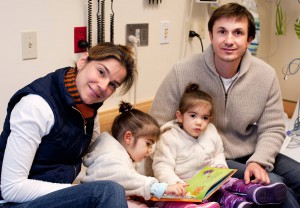
Colombian twins Miranda and Olivia Agudelo (with their parents) were the first patients in a clinical trial aimed at making the bone marrow transplant process less toxic.
One thing that most people don’t realize about stem cell transplants (also called bone marrow or hematopoietic stem cell transplants) is that for patients, the transplant itself is probably the easiest part of the process. The grueling part is the preparation for a transplant, called conditioning.
There’s been a lot done at Dana-Farber/Children’s Hospital Cancer Center (DF/CHCC) and elsewhere to make conditioning less toxic. With a new clinical trial in a rare genetic syndrome called dyskeratosis congenita (DC), doctors at DF/CHCC are taking an even bolder step. Full story »
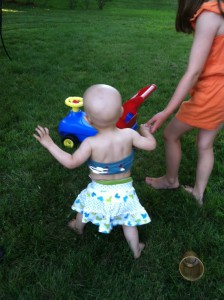
Saoirse Fitzgerald taking a walk wearing her CareAline wrap. The wrap, designed by her mother, helped keep her central line secure. (Mike & Kezia Fitzgerald)
Over the last year and a half I’ve written 70-plus stories about innovations by doctors, nurses and other staff at Boston Children’s Hospital. I haven’t yet written a story about a patient innovation. But that doesn’t mean that patients and their families aren’t out there innovating.
Case in point: Kezia Fitzgerald saw pretty quickly that there was a problem she might be able to fix. Her daughter Saoirse (pronounced Seer-sha), who had been diagnosed with neuroblastoma, had just had a PICC line put into her arm at Dana-Farber/Children’s Hospital Cancer Center to infuse drugs and fluids. Within a day, Saoirse was tugging at the line, trying to pull off the tape that was keeping it in place. “It was irritating her skin pretty badly,” Kezia says. “She was really uncomfortable.”
Kezia, herself at the time fighting Hodgkin lymphoma (read the family’s story on our sister blog, Thriving), wanted to make her daughter as comfortable as she could. Full story »
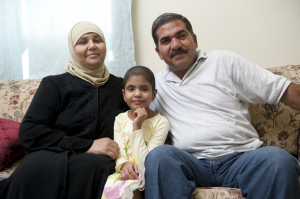
Maryam Idan (center), a young Iraqi girl with sickle cell disease, was lucky: she could be cured with a stem cell transplant. Leslie Lehmann, MD, wants to make such transplants an option for more sickle cell patients.
I was surprised when chatting recently with Leslie Lehmann, MD, clinical director of the Stem Cell Transplantation Program at Dana-Farber/Children’s Hospital Cancer Center (DF/CHCC). She turned to me and asked, “Did you know there’s been a cure for sickle cell disease for nearly 40 years?”
I had to admit that I didn’t. I’ve always thought of sickle cell—a painful and debilitating disease caused by an inherited mutation that makes red blood cells stiffen into a characteristic sickled shape—as a chronic disease to be managed, not one that could be cured.
I’m not alone in that belief. Lehmann often asks this question when she give talks for medical students, residents and other physicians. Their reaction is puzzlement, then a shaking of heads.
The cure is there, though. It’s a stem cell (aka bone marrow) transplant. The catch is that it’s not available to everyone—but for reasons that Lehmann thinks can be overcome. Full story »

(saeru/Flickr)
When you look at an apple, no matter what variety, on the surface you can be pretty sure it’s actually an apple. From there, you can make lots of assumptions about it, like how it will taste when you bite into it and what will happen if you plant the seeds in your yard.
With cancer, we can’t make those kinds of assumptions. While two tumors from the same location in two patients may look the same, doctors and researchers have come to recognize that their behavior and the mutations driving them can be radically different, as can their response to therapy.
With that recognition, physician/scientists like Scott Pomeroy, MD, PhD, the neurologist-in-chief at Boston Children’s Hospital, are taking a deeper look at the tumors they commonly see and asking whether what on the surface looks like one kind of tumor might actually be something completely different. Pomeroy in particular has applied this view to one of the biggest questions in pediatric cancer: Why do medulloblastomas, the most common malignant childhood brain tumor, behave so differently from child to child? Full story »

We put lots of hurdles up to slow or stop cancer growth, but cancer cells often get over them. The more we know about the how they do it, though, the more we can do about it. (Phil Roeder/Wikimedia Commons)
Leukemia and other cancer cells are really good at hurdling over the obstacles we throw at them. It’s the whole basis of drug resistance: we attack a mutation with one drug, and another mutation arises to cancel out the drug’s effect. Or the cell ramps up other pathways to compensate for the one blocked by the drug.
But the more we learn about the backup systems cancer cells use to get around our treatment strategies, the better we can get at controlling or eliminating cancer cells. Alex Kentsis, MD, PhD, and Thomas Look, MD, of Dana-Farber/Children’s Hospital Cancer Center, came across one such backup while trying to find which genes a blood cancer called acute myeloid leukemia (AML) relies on to survive. In a nutshell: the cells talk to themselves—chemically, that is. Full story »
The pain of sickle cell disease can be unbearable. But there's a new view emerging on how that pain comes about, one that has spurred a new clinical trial aimed at stopping the pain at its source. (stevendepolo/Flickr)
If there’s one thing most patients with sickle cell disease will agree on, it’s that sickle cell hurts. A lot.
The characteristic rigid, sticky, C-shaped red blood cells of this inherited disease tend to get stuck in the small blood vessels of the body. If so many get stuck in a vessel that they cut off blood flow, the body sends out a warning signal in the form of searing pain that doctors call a pain or vaso-occlusive crisis (at least, that’s the historic view; more on that in a minute). The pain can happen anywhere in the body, but most often occurs in the bones of the arms, legs, chest and spine.
Preventing flare-ups—and stopping them when they happen—is a major part of the care plan for any patient with sickle cell. Right now doctors try to avoid pain crises largely by diluting a patient’s blood with fluids or transfusions, thereby keeping the numbers of sickled cells relatively low.
What these treatments don’t do is tackle the pain directly. Doctors can use pain medications, but over time, patients can become tolerant to painkillers, requiring ever-larger doses. What’s needed is something that can stop the complex cascade of events that ignite a pain crisis. Full story »

Frequent transfusions can leave the body overloaded with iron. Ellis Neufeld is helping find new ways of scrubbing that extra iron from the blood. (Research Indicates/Flickr)
In some children the body’s machinery for making red blood cells just doesn’t work right. Conditions like Diamond Blackfan anemia or thalassemia can leave the body anemic, struggling to keep up with its own demands for oxygen. And the misshapen red blood cells of sickle cell disease can get stuck in small blood vessels and cause anemia, organ damage and great pain.
Right now, the most effective way to care for these blood disorders is with blood transfusions. But unlike trauma or surgery, a single transfusion doesn’t solve the problem for people with life-long anemias or sickle cell. Most people with thalassemia, for example, have transfusions every month for their entire life.
“After about 20 transfusions, you reach a point where the body is overloaded with iron from all of the extra hemoglobin that’s been introduced into it,” says Ellis Neufeld, MD, PhD, director of the Thalassemia Program at Dana-Farber/Children’s Hospital Cancer Center (a partnership of Boston Children’s Hospital and Dana-Farber Cancer Institute). “The body has no way to actively remove iron on its own, so the iron starts to build up.” Over time, this can damage the liver, heart, pancreas and other major organs.
Over the last 40 years, a lot of work at DF/CHCC and elsewhere has gone into what’s called chelation therapy: drug-based treatments that scrub the blood of excess iron. Right now there are three chelating drugs in broad use: deferoxamine, deferasirox and deferiprone. They work well for many patients, but have their disadvantages. Full story »
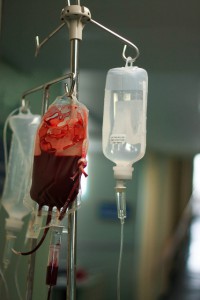
What time is the right time to give a transfusion? Doctors at Boston Children's are turning a fresh eye on transfusion guidelines for children. (@alviseni/Flickr)
Cancer. Trauma. Sickle cell disease. Surgery. There are many reasons why a child might need a blood transfusion, but they all share a common theme: the need to replace blood or blood products (e.g., red blood cells, platelets) that have been lost or consumed, or make up for defects that keep the body from producing them in adequate amounts.
And though transfusions can be life saving, they come with risks, such as iron overload, inflammation or disease (a very low risk, thanks to improved screening tests). And blood products are expensive and scarce—another reason to be prudent about transfusions.
“There’s little science behind physicians’ current practices when deciding when to transfuse a patient,” says Jenifer Lightdale, MD, MPH, of Boston Children’s Hospital’s Division of Gastroenterology and Nutrition. “Many doctors use criteria their mentors passed down to them, which their mentors passed down to them, and so on. But ideally, the decision should be based on evidence, not tradition.” Full story »
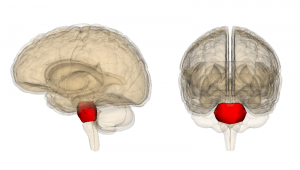
Nestled in the pons (the red area above), the area that controls breathing, DIPG tumors have been impossible to biopsy and analyze for therapeutic insights. Until now. (MEXT Integrated Database Project/Wikimedia Commons)
Brain tumors can be very difficult to treat, but at least we know what to do about them. For years, a mix of surgery, radiation and chemotherapy has been used to treat brain tumors like medulloblastoma.
These treatments are fairly successful, but for a rare, almost always fatal tumor called diffuse intrinsic pontine glioma (DIPG), we haven’t had any success—in fact, we haven’t known where to start.
The problem has to do with where DIPGs are located: nestled among the nerves in a portion of the brain stem, the pons, that controls critical functions like our breathing, blood pressure and heart rate.
“For 40 years, we lacked the neurosurgical techniques to biopsy DIPGs safely,” say Mark Kieran, MD, PhD, director of the Brain Tumor Program at Dana-Farber/Children’s Hospital Cancer Center (DF/CHCC). “In fact, one of the first lessons every oncologist is taught still is, ‘Don’t biopsy brain stem gliomas.’ The dogma was that the risk of severe or fatal damage was too great.” And because we couldn’t biopsy them, we couldn’t study them to learn what makes them tick.”
A lot can change in four decades. Techniques for operating on the brain have advanced considerably, as have the tools for probing tumors at the molecular level. So, looking to turn the dogma about DIPGs on its head, Kieran has launched a clinical trial that aims to use advanced surgical and diagnostic tools to target and individualize DIPG treatment. Full story »
Lewis Silverman, MD, thinks he may have a powerful new tool for treating children with relapsed acute lymphoblastic leukemia. (VashiDonsk/Wikimedia Commons)
The news that your child has cancer always comes as a shock, but for one cancer, acute lymphoblastic leukemia (ALL), parents can take comfort in the fact that doctors are really good at treating it. The cure rate for ALL has, over the last 40 years, climbed to nearly 90 percent.
Less comforting is the fact that some 10 to 20 percent of children who initially respond well to treatment suffer a relapse within five years. And right now, the drugs at our disposal aren’t very good at turning a relapse back into a remission.
“We have standard treatment regimens for newly diagnosed and relapsed ALL, both of which rely heavily on corticosteroids like prednisone and dexamethasone,” says Lewis Silverman, MD, director of the Pediatric Hematologic Malignancy Service at Dana-Farber/Children’s Hospital Cancer Center (DF/CHCC). “But we know that leukemias with any level of steroid resistance are more likely to relapse. Anything we can do to overcome that resistance would let us help many children.”
Silverman has launched a clinical trial that will try a new strategy for tearing down ALL cells’ barriers against corticosteroids. Full story »















